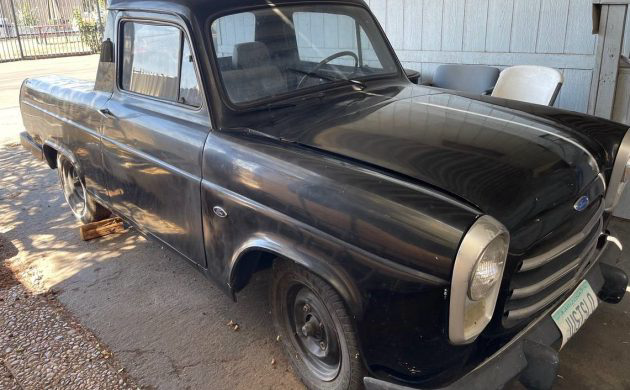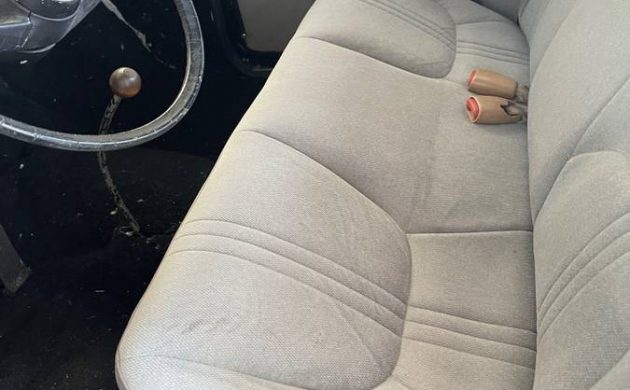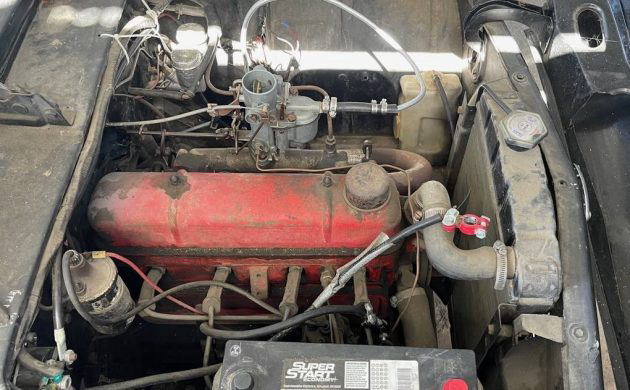The Ford Anglia was a small British sedan that was built between 1939-67 and sold nearly 1.6 million copies. It had several iterations, including the 100E model from the 1950s. While the seller says this is a 1950 Ford pickup, the front clip suggests that it’s more likely a 1957 Squire, a small station wagon that has been converted into a little truck. It’s been sitting for a time, so some TLC will be needed. Located in Fontana, California, this English Ford is available here on craigslist for $6,500.
Operating on the assumption this pickup is based on a 100E, the Anglia was a completely new car in 1953 and that design would stay in place through the balance of the decade. It would receive a facelift in 1957, which produced the headlight and grille arrangement found on the seller’s custom pickup. These sedans were powered by an 1172 cc “side valve” inline-4 that produced a whopping 36 hp that could propel the little machines up to about 70 mph. The shifting of gears was handled by a 3-speed transmission that could be fitted with a semi-automatic “Manumatic” gearbox.
This Anglia may have been built for use outside the UK as it has left-hand drive. No background on the truck is provided, so we’re making a few guesses here. It comes with a clean Arizona title, so the vehicle must have spent at least part of its life in the U.S. Southwest. The mileage is unknown due to the modifications made to the truck, but it looks to be in good physical condition. Because it’s been idle for a time, the carburetor is going to need a rebuild, but that’s the only mechanical issue the seller mentions.
If this was a standard Anglia sedan (or saloon as the Brits called them), it would be a rare sight in the U.S. But as a potentially one-off custom job, the chances of seeing another one quite like it may be slim to nil. The work needed to get it running again could be minimal, so is this a project one of our fans of English cars is ready to take on?






Has to have been homebuilt. A factory-authorized conversion would’ve likely started with one of the Thames panel vans which had a higher roof and shorter(!) rear overhang than the sedans and used the front doors from the four-door Prefect.
The engine picture seems to depict a rocker arm cover. So this engine is not a flathead, or “side valve”, as most Anglia had in the time.
Yes, obviously an OHV engine. That is very much in its favor; although the 100E looks a lot like a miniature Model A engine, it was actually pretty fragile, as I discovered one day. I had the wagon version, and among its shortcomings was its habit of regularly jamming the ring gear, which I would fix by inserting the “starting handle” (hand crank) and giving it a short nudge backwards. One day I did that, there was a loud SPONG! and the crankshaft broke. Had I not been an all-but-penniless Community College student ) suppose I could have looked for another engine, but paying to have it hauled off was all I could afford.
It was a pleasant little thing to drive, though, and the chassis and suspension were well-designed. The Anglia that followed was much more capable, though, and the OHV engine was the first of some really potent successors.
This looks like a worthwhile project, for those so inclined. As evident in the pictures someone started on this little Britt at some point already. If it’s spent it’s life in Arizona it should have some good bones underneath. I’m surprised that it’s made it this long, without being perched on a 4wheel set, or a massive blower and a pair of wheelie bars being it’s new personality.
The taillights look like Datsun Bluebird so it probably is a one off. They did make an estate wagon version.
The engine’s an OHV; if it’s Ford, it could be a 1500 (from Cortina etc) which would push it along nicely.
I am sure that is not a Cortina engine, but a 1500cc Ford Consul.
Aye, same engine; generally referred to as “pre-crossflow”. Early Cortinas had 1500s, I think.
The Consul Classic’s vacuum wipers were – I think – the reason behind my dad’s dislike of Fords.
I think you’re right about that. I just looked in the Floyd Clymer’s British Ford Owner’s Handbook and that engine appears to be the one from the Consul.
Not the Cortina Kent motor. 1500cc, but no relation to the later motors.
I owned the very first CONSUL Cortina as it was first known, that came off the South African production line in 1962 and given to the CEO’s wife to use until the four door came out. It was then sold to one of the guys working on the production line from whom I bought it 3 years later, and it had a 1200cc, 3 main bearing engine. A real Friday/Monday built car that my wife drove Monday to Friday and I spent Saturday or Sunday getting it back on the road for another five days! I discovered that one of the pressure plate lock nuts was unscrewing itself causing the clutch to slip. I could get that gearbox out on the floor every Saturday or Sunday morning, re adjust the toggles, and get it back in the car within an hour and a half. I had finally had enough so the last time I had it out I replaced the clutch plate, release bearing, adjusted the toggles, and welded the lock nuts in place! That fixed it forever. I love Fords.
Too bad there aren’t more mechanical details and/or pictures of the undercarriage, frame, and what’s behind all the “tin” behind the cab. The instrument panel looks homemade, too. Lots of questions……….
If it did start life as a wagon, it’s too bad they didn’t leave the tailgate on the back – maybe it had been hit or something.
That is a very nice looking interior bench seat, which also looks new, and, it seems to me, is nicer-looking than even the original wagon would have had – I wonder what the story on that is – I’ve never seen another like it.
I don’t even think that it’s a Ford engine, judging by the tappet cover.
That engine looks like it’s from a Ford Consul. I’ve got a Floyd Clymer’s British Ford Owner’s Handbook and the illustrations match right up.
No such thing as a pickup version was ever offered.
A company called kennex I think it was or Martin Walter did some conversions on the later 105 E van.
But I don’t think anyone offered such a conversion on the 100E.
The 1500 consul & the 1500 pre crossflow are two different engines.
ck out the zepher (p/u: Ford Zephyr Mark II Coupe Utility) and Abbot from justa lill later – to see mini tri-fives as wagons & early suvs…
https://tractors.fandom.com/wiki/Ford_Zephyr
I checked out the website as suggested but couldn’t understand why they said that the Zephyr Mk 2 convertible body flexed so that not many of them survived. The 1959 Convertible that I restored had a moulded/pressed steel insert under the body and a pressed steel surround enclosing the propshaft. If the car was jacked up in order to change a wheel the doors could still be opened and closed easily. Difficult to tell as I have never been able to check on another Mk 2 Zephyr. As for the rest of them I have had them all from Mk1,2,3 and 4 and they were all fantastic cars. They all had some problems as the Mk 1 differential whined like hell. The Mk 2 door catches were useless, The Mk 3 column change didn’t, and the Mk 4 rear disc calipers seals popped out regularly. Other than that, no problems.